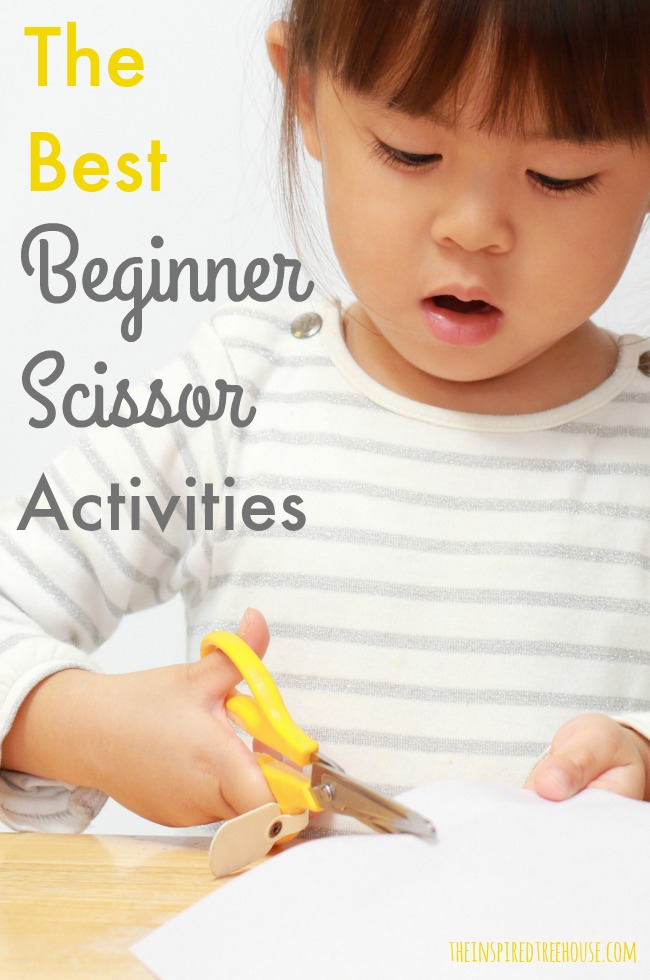These simple beginner cutting activities are great for helping young kids and kids with fine motor delays to learn how to snip paper and move scissors across paper.
*This post contains affiliate links. Read more.
As a pediatric occupational therapist, when I first start teaching kids how to use scissors, I start with snipping – simply getting used to that motion of grasping, opening, and closing the scissors.
But usually, it’s not enough to just have kids snip along a strip of paper. They need something more interesting, something that gives a purpose to their hard work!
After all, as kids learn to use scissors, they’re learning how to integrate and coordinate a complex series of actions – grasping the scissors properly, positioning them on the paper, opening and closing them, stabilizing their paper with their non-dominant hand, moving scissors forward across the paper, and eventually following a cutting line with their scissors. That’s a lot of effort, right?
As we start with the basic action of grasping and opening and closing the scissors (and gradually advancing to moving scissors across paper), it can help to show kids that all of that snipping and cutting has a clear purpose. So I use a variety of different strategies, crafts, and cutting activities to keep kids motivated and interested in early scissor activities.

RISE With Sensory Course
Are you ready to learn powerful sensory strategies to support kids’ sensory needs so they can RISE to their full potential?
Whether you’re a parent or a professional, this course is for you!
The RISE With Sensory Course is This class is AOTA approved for 7 hours (.7 CEU) and is the perfect starting point for new therapists, or refresher for experienced therapists.
Looking for a streamlined approach for working with kids with sensory concerns and for communicating clearly with parents and caregivers about sensory processing?
Click here to learn more!
When Should You Introduce Kids to Scissors?
Many parents and educators ask how old kids should be before they introduce scissors at home or in the classroom. My answer usually surprises people! I recommend introducing play and exploration with scissors as early as 2 years old (with supervision, of course!). Early exposure through simple cutting activities is the best way to help kids learn good positioning and habits with scissors.
There are lots of great Fine Motor Skills Activities for 2-3 Year Olds that can help strengthen little hands and get them ready for activities like cutting with scissors! Curious about the skills kids should be developing around this time? Learn more about 2 and 3-Year-Old Milestones here!
Here are some of my favorite beginner scissor activities for kids!
Beginner Cutting Activities for Kids
1 || Lion’s Mane
For this simple cutting activity, I cut a circle out of yellow or orange paper and draw a lion’s face in the middle. Then, I tell the child that we need to give the lion a mane! I help the child grasp scissors properly to snip along the edge of the paper, all the way around the circle. And boom! Snipping practice, resulting in an awesome lion’s mane!
2 || Grassy Bug Hideout
Start by drawing several pictures of bugs along the bottom of a piece of paper. You can also find pictures online and cut them out if you want to get fancy. Then, provide the child with a strip of green paper, wide enough that it will cover the bugs at the bottom of the paper if you lay it over top of them.
Have the child snip along the edge of the green strip of paper to make grass. Tape the unsnipped edge of the green strip along the bottom of the paper so it can flip up (covering the bugs) or down (revealing the bugs).
3 || Super Simple Sesame Street Characters
What kid doesn’t love Sesame Street? A few simple snips and kids can create their own simple Sesame Street character craft!
4 || Leafy (or Snowy) Tree Cutting Activity
Kids can practice snipping while creating an awesome tree craft! For fall, cut a circle out of red, yellow or orange paper and have kids snip around the edge to create a leafy, fringy edge. Add a brown trunk and you’re all set!
For spring or summer, make the circle green. For a winter tree, make it white and add some glitter for a snowy sparkle. You can also add red circles for apples, pink pieces of tissue paper for flower blossoms, or orange/brown/red tissue paper pieces to make an autumn masterpiece.
Bonus points for creating a pink tree that looks like The Inspired Treehouse logo! If you do, make sure to share pics with us on Facebook!
5 || Haircut!
Don’t worry, we don’t mean a real haircut (although this seems to be a common rite of passage for kids as they learn how to use scissors)! This Sammy Scissors cutting activity from Lalymom is a much better option!
6 || Mini Monsters
This is an awesome one for Halloween! Cut circles out of different colored paper. Have kids snip around the edges to create a hairy monster! Add googly eyes and other spooky facial features!
7 || Flower Garden
Again, start with a handful of colorful paper circles. Have kids snip around the edges to make the flower petals. Glue them onto paper, add green stems and a circle in a contrasting color to create the center of the flower.
8 ||Sunshine
Once your flower garden is complete, you’ll need to add a sun, of course! You know the drill – cut out a yellow or orange circle and have kids snip all the way around the edge to make the rays!
9 || The Cutest Hedgehog Ever
I’m in love with this little hedgehog cutting craft from Paging Fun Moms. All you need is a paper plate, a marker, and some scissors!
10 || Cutting Practice Spider
I’m also loving this creative cutting practice spider from Lalymom – a surefire way to keep kids engaged and interested in cutting practice!
11 || Snipping Straws
Sometimes it helps to start practicing with snipping scissors on a material other than paper. It’s a great way to let kids explore how the scissors work and how they feel in their hand. Snipping straws is one of my favorite activities because there’s a great element of cause and effect! Snip off a piece of a straw, and it goes bouncing up into the air! So. much. fun.
12 || Snipping Play Dough
This is another great way to help kids experiment with scissors and is a favorite activity of our toddlers at The Treehouse. Snipping against resistance is also great for building hand strength and for providing proprioceptive input. See below for a link to a play dough set that has a great pair of practice scissors inside.
13 || Sticker Snipping
Stickers are probably my most-used snipping/cutting practice accessory. You can use them in so many ways to motivate kids and keep them interested while also providing a great visual target. Place stickers in a line across a strip of paper and have them snip in between (or on) each one. Place one toward the center of a small piece of paper and have kids work on cutting forward across the paper until they reach the sticker target.
14 || Paint Sample Cutting
If you’re looking for a ready-made (and free!) cutting and snipping practice tool – look no further than your local hardware store! I love using paint samples as kids begin to learn how to cut on lines. The white lines are a great contrast against the paint colors, strips are the perfect width for beginners, and the paper has some weight to it, which makes it easier to cut.
Other Tips for Beginner Cutting Skills
Use Heavier Paper
Cutting paper that is a little heavier (e.g. card stock) is often easier for beginners because it remains rigid as the child holds it in in their stabilizing hand. This kind of paper also offers the benefit of cutting against resistance, which builds hand strength and provides beneficial proprioceptive input to increase awareness in those hands!
Thumbs Up Cutting
This is a well-known strategy among occupational therapists, but it’s one of my go-tos for scissor beginners. Using the verbal prompt to cut with “thumbs up” helps kids position their hands correctly in a neutral position. I often place stickers on both of the child’s thumbs as well, to add a visual component to this cue. I tell the child that they should be able to see both stickers while they’re cutting – the one on the stabilizing hand and on the hand that’s grasping the scissors.
Use Tape as a Visual Cue
I also place red (or other colored) tape around the small hole (the thumb hole) of the scissors and cue the child to put their thumb in the red hole. This is great for kids who always seem to grasp the scissors upside down.
Use Stickers for the Stabilizing Hand
Finally, I often place a sticker on the paper where the child’s stabilizing hand should go to give them a simple visual prompt.
Some of Our Favorite Scissors for Beginners
Training Spring Scissors
We love using spring scissors with young kiddos to help them get the hang of the open and close motion!
Play-Doh Starter Set
Strengthen little hands with this little starter set – the perfect 2-year-old birthday gift.
Loop Spring Scissors
Another great pair of spring-loaded scissors with a slightly different style.
Training Helper Scissors
These training scissors have a set of holes for grown up hands and a set of holes for little hands, so both can grasp at the same time! This can help kids get the hang of accuracy and speed.
Child-Safe Scissor Set
A great option for cutting play dough and practicing snipping paper without the risk of sharp scissors!
Other Great Beginner Cutting Skill Activities for Kids
Creative Cutting Practice for Kids
Here, you’ll find lots of great unexpected ways to practice the skills kids need to be able to cut with scissors!
Teaching Kids How to Use Scissors
Even more awesome tips for promoting efficient cutting in young kids.
Cool Trick to Help Kids Learn to Turn the Paper While Cutting
Love this idea to support kids who are ready to cut on curved lines or cut out shapes.
The Best Kids Tongs
Great for helping kids practice the motion for cutting with scissors!
What are your favorite beginner scissor tips, tricks, and activities for kids? Share them in the comments below!


Latest posts by Claire Heffron (see all)
- Fairy Tale Games and Toys - April 12, 2024
- The Best Emotional Regulation Books for Kids - April 8, 2024
- Fairy Tales Games: Gross Motor Obstacle Course - April 4, 2024


[…] kids have practiced these creative cutting ideas, they’re ready to move on to beginner cutting activities and eventually cutting on lines. Finally, it’s time to start learning how to cut out […]